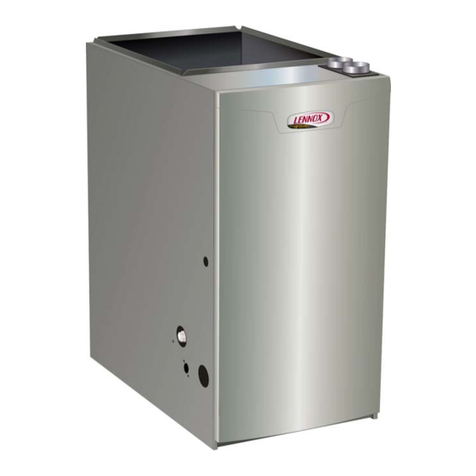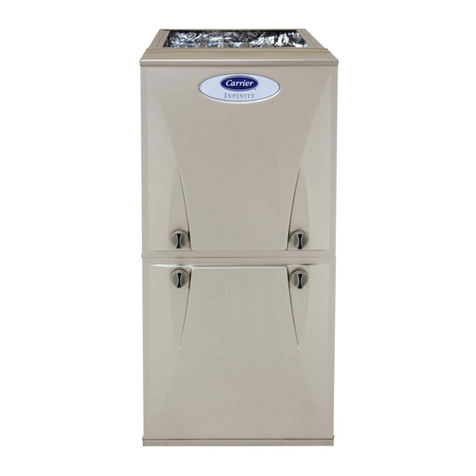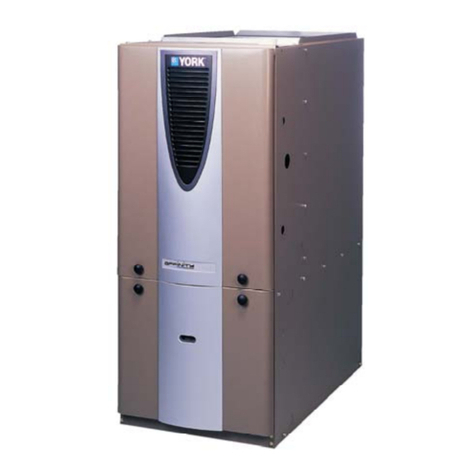ETL PLB210 Low Boy User manual

670-000-001/0204
Oil furnace
PLB210 Low Boy
Furnace Manual
Contents Page
Read this first!............................................................................ 2
Prepare furnace location............................................................ 3
Prepare furnace and place in position ....................................... 6
Connect supply and return ducts ............................................... 7
Venting..................................................................................... 10
Connect fuel oil piping ............................................................. 11
Wire furnace and burner .......................................................... 13
Start-up .................................................................................... 17
Checkout procedure ................................................................ 18
Troubleshooting ....................................................................... 19
Service and maintenance ........................................................ 20
Components and replacement parts........................................ 22
Dimensions and ratings ........................................................... 24
Owner’s information................................................................. 26
Hazard definitions
Hazards that will cause severe personal injury,
death or substantial property damage.
Hazards that can cause severe personal injury,
death or substantial property damage.
Hazards that will or can cause minor personal
injury or property damage.
Special instructions on installation, operation or
maintenance that are important but not related to
personal injury or property damage.
INSTALLER – Read all instructions before
installing. Read page 2 first. Follow all instructions
in proper order to prevent personal injury or death.
x Consider ducting, fuel supply, venting and
installation when determining furnace location.
x Any claims for damage or shortage in shipment
must be filed immediately against the transportation
company by the consignee.
Do not store or use gasoline or other flammable
liquids or vapors near this furnace or any other
appliance.
Ventilate house while operating furnace for the first
time. Odors may be emitted for a brief period.
Do not alter this furnace in any way. The
manufacturer will not be liable for any damage
resulting from changes made in the field to the
furnace or its components or from improper
installation. Failure to comply could result in severe
personal injury, death or substantial property
damage.
USER – Please read the following. Failure to
comply could result in severe personal injury, death
or substantial property damage.
x This manual is for use only by your qualified
heating installer / service technician.
x Please see the Owner’s information only, on back
page of this manual.
x Have the furnace serviced by a qualified service
technician, at least annually.
This manual must only be used by a qualified
heating installer / service technician. Furnace and
burner must be installed and serviced only by a
qualified heating installer / service technician.
Failure to comply could result in severe personal
injury, death or substantial property damage.
When calling or writing about the furnace – Please
have furnace model number and serial number from
the rating label. You may list the serial number and
model number in the space provided on the
“Installation and service certificate” found on
page 18.
DANGER
WARNING
CAUTION
NOTIC
E
WARNING WARNING
WARNING
WARNING
WARNING
CAUTION
NOTIC
E
KEEP THESE INSTRUCTIONS
WITH FURNACE FOR FUTURE
REFERENCE.

2670-000-001/0204
READ THIS FIRST!
Failure to adhere to the guidelines below can result in severe personal injury, death or substantial property damage.
Service and maintenance –
To avoid electric shock, disconnect electrical supply before
performing maintenance.
To avoid severe burns, allow furnace to cool before performing
maintenance.
Perform service and maintenance as described in this manual
and the burner manual.
Do not attempt to make adjustments to the blower or motor while
the furnace is in operation. Disconnect power to the furnace and
be sure all parts have stopped moving before attempting
adjustments or maintenance.
The burner must be set up and adjusted using combustion test
instruments. Visual examination of the flame alone cannot
determine combustion performance.
Operation -
Do not use the furnace as a construction heater.
Do not operate any furnace if the heat exchanger is damaged,
corroded or pitted. Toxic flue products could enter the air
stream.
Do not jumper, attempt to by-pass or override any limit control.
Do not block flow of combustion or ventilation air to furnace. Do
not block or obstruct the air openings in the furnace casing.
Do not store or use combustible materials, gasoline, or other
flammable liquids or vapors in the furnace area.
Do not operate the furnace if the furnace area will be exposed to
air contaminants as described on page 5.
Should overheating occur, do not turn off or disconnect electrical
supply to furnace. Instead, shut off the oil supply at a location
external to the appliance, if possible.
Do not use this furnace if any part has been under water.
Immediately call a qualified service technician to inspect the
furnace and to replace any part of the furnace, control system or
burner that has been under water.
Do not operate furnace if temperature rise through heat
exchanger exceeds 85oF.
Inspect, clean and replace (if necessary) return air filter
regularly.
Do not obstruct return air grills or supply air outlets.
Supply only #2 fuel oil to the burner. Never attempt to use
gasoline, a mixture of gasoline and oil, waste fuel, refuse or any
other substance in the burner of furnace.
Installation -
Do not block flow of combustion or ventilation air to furnace. Do
not block or obstruct the air openings in the furnace casing.
Connect furnace only to a functional vent system in good
condition. Place the furnace to allow proper venting, with the
shortest possible venting and minimum number or elbows.
Always connect and seal a return air duct to the furnace unless
the furnace is located in a large space, such as an unpartitioned
basement. Route the return air duct to an adjacent room if no
return air manifold is used.
Install furnace maintaining minimum clearances for service and
separation from combustible surfaces described in this manual.
Install, start-up, service and maintain burner per instructions in
this manual and the burner manual.
Verify burner is properly inserted through the combustion
chamber opening.
Furnace must be installed so that burner and control system
components are protected from dripping, spraying water or rain
during operation or service.
If installing an air conditioning evaporator coil, install the coil
downstream of, or in parallel with, the furnace to prevent
condensation on the furnace heat exchanger. If the coil is in
parallel, provide means to prevent flow of chilled air into the
furnace, including an interlock to prevent simultaneous operation
of heating and air conditioning.
Apply the following suggestions to prevent unsatisfactory operation of the furnace.
Installation –
Be sure to level the furnace, using a spirit level on the front and
one side. If the furnace is not level, oil can drip into the
combustion chamber after burner cycling, causing fouling of the
heat exchanger and the burner head.
Make sure all legs are in contact with the floor to distribute the
load and prevent the possibility of undue noise or vibration.
Avoid locating return grills in rooms that may contain undesirable
odors.
Never locate a return air grill closer than approximately 20 feet
from the furnace.
Locate the furnace near the center of the supply and return duct
systems.
Always check the size of the ducts on a replacement installation,
particularly if adding air conditioning.
WARNING
NOTICE

PLB Oil Furnaces – Furnace Manual
670-000-001/0204 3
1 Prepare furnace location
Pre-installation checklist
Verify code compliance
Local, state, provincial, and national codes, laws, regulations
and ordinances
NFPA-31, Installation of Oil-Burning Equipment
National Electrical Code
All local codes and/or regulations take precedence over the
instructions in this manual and should be followed accordingly.
PLB furnaces, their burners and controls met safe
lighting and other performance criteria when furnace
underwent tests specified in Underwriters Laboratories
Standard UL727.
Check location and furnace specifications
Furnace heating capacity
Space is large enough to provide required clearances
Verify the installation will meet the requirements of this manual :
Clearances (page 3)
Combustion/ventilation air openings (page 4)
Supply air duct (page 7)
Return air duct (page 7)
Vent system (page 10)
Fuel oil piping (page 11 plus burner manual)
Electrical connection (page 12)
Clearances
Minimum clearance to combustible materials
Install the furnace, ductwork and vent such that no combustible
surface is closer than listed in Table 1.
Flue pipe clearances must take precedence over
jacket clearances (listed below).
Service accessibility clearances
Provide no less than the minimum clearances given in Table 1 to
ensure the furnace can be properly operated, serviced and
maintained.
Always apply whichever clearance is LARGER – combustible
construction or service accessibility.
Flooring and foundation
Flooring
PLB furnaces are approved for installation on combustible flooring,
but must never be installed on carpeting.
Do not install furnace on carpeting even if foundation
is used. Fire can result, causing severe personal
injury, death or substantial property damage.
Foundation
Provide a solid brick or minimum 2 inches thick concrete
foundation pad if any of the following is true :
x the floor can become flooded.
x the furnace mounting area is not level.
Residential garage installations
Take the following special precautions when installing the furnace in
a residential garage. Il the furnace is located in a residential garage :
x Mount the furnace a minimum of 18 inches above the floor
of the garage.
x Locate or protect the furnace so it cannot be damaged by a
moving vehicle.
Table 1 Minimum clearances
NOTIC
E
NOTICE
WARNING
Location
Left or right 6”
Other side left or right 1”
Back Furnace 6”
Furnace or plenum 1”
Horizontal warm air duct within 6 feet of furnace 1”
Bottom Furnace (combustible floor) 0”
Horizontally or below flue pipe 9”
Vertically above flue pipe 9”
Front From burner 24”
Minimum clearances – combustion materials (inch)
Sides
Top
Flue pipe
Application

PLB Oil Furnaces – Furnace Manual
4670-000-001/0204
1 Prepare furnace location (continued)
Air for combustion and ventilation
Adequate combustion and ventilation air ensures
proper combustion and reduces risk of severe
personal injury or death from possible flue gas
leakage and carbon monoxide emissions.
Do not install exhaust fan in furnace room.
Consider building construction
Older buildings with single-pane windows, minimal weather-stripping
and no vapor barrier often provide enough natural infiltration and
ventilation without dedicated openings.
New construction or remodeled buildings are most often built tighter.
Windows and doors are weather-stripped, vapor barriers are used
and openings in walls are caulked. As a result, such tight
construction is unlikely to allow proper natural air infiltration and
ventilation.
For buildings with tight construction, provide openings directly to
outside or to a ventilated crawl space or attic. Size the openings to
the same specifications as for the furnace location per the following
paragraphs.
Follow state, provincial or local codes when sizing adequate
combustion and ventilation air openings. In absence of codes, use
the following guidelines when furnace is in a confined room (defined
by NFPA 31 as less than 7200 cubic feet per 1 GPH input of all
appliances in area. A room 8 ft. high x 30.0 ft. x 30.0 ft. is 7200 cu.
ft.).
Provide two permanent openings
Openings locations
One within 12 inches of ceiling, one within 12 inches of floor.
Minimum height or length dimension of each rectangular opening
should be at least 3 inches.
When inside air is used
Each opening must freely connect with areas having adequate
infiltration from outside. Each opening should be at least 140 sq. in.
per 1 GPH input (1 sq. in. per 1000 BTU input) of all fuel-burning
appliances plus requirements for any equipment that can pull air
from room (including clothes dryer and fireplace).
When outside air is used
Connect each opening directly, by ducts to the outdoors, or to crawl
or attic space that freely connects with outdoors. Size per below :
x Through outside wall or vertical ducts – at least 35 sq. in. per 1
GPH input (1sq. in. per 4000 BTU input) of all fuel burning
appliances plus requirements for any equipment that can pull air
from room (including clothes dryer and fireplace).
x Through horizontal ducts – at least 70 sq. in. per 1 GPH furnace
input (1 sq. in. per 2000 BTU input) of all fuel-burning appliances
plus requirements for any equipment that can pull air from room
(including clothes dryer and fireplace).
x Where ducts are used, they should have the same cross-
sectional area as free area of openings to which they connect.
Compensate for louver, grille or screen blockage when
calculating free air openings. Refer to their manufacturer’s
instructions for details. If unknown, use :
x Wood louvers, which provide 20-25 % free air.
x Metal louvers or grilles, which provide 60-75 % free air.
Lock louvers in open position or interlock with equipment to
prove open before furnace operation.
Basement installations
When the furnace is located in an unconfined space, such as an
unpartitioned basement, adequate air should normally be available
without additional opening. An unconfined space is defined as one
having no less than 50 cubic feet room volume per 1,000 BTU/h
input of all appliances in the space.
If the house is of tight construction, provide air openings to the
basement directly from outside or from a ventilated attic. Size the
openings as described above under “When outside air is used”.
WARNING
WARNING

PLB Oil Furnaces – Furnace Manual
670-000-001/0204 5
1 Prepare furnace location (continued)
Air contamination
Please review the following information on potential combustion air
contamination problems.
See Table 2 for products and areas which may cause contaminated
combustion air.
To prevent potential of severe personal injury or
death, check for products or areas listed below
before installing furnace. If any of these
contaminants are found :
x Remove contaminants permanently.
-OR-
x Isolate furnace and provide outside combustion air. See
national, provincial or local codes for further information.
Table 2 Corrosive contaminants and likely locations
WARNING
Products to avoid
Spray cans containing chloro/fluorocarbons
Permanent wave solutions
Chlorinated waxes/cleaners
Chlorine-based swimming pool chemicals
Calcium chloride used for thawing
Sodium chloride used for water softening
Refrigerant leaks
Paint varnish removers
Hydrochloric acid/muriatic acid
Cements and glues
Antistatic fabric softeners used in clothes dryers
Chlorine-type bleaches, detergents, and cleaning solvents found in
household laundry rooms
Adhesives used to fasten building products and other similar
products
Areas likely to have contaminants
Dry cleaning/laundry areas and establishments
Swimming pools
Metal fabrication plants
Beauty shops
Refrigeration repair shops
Photo processing plants
Auto body shops
Plastic manufacturing plants
Furniture refinishing areas and establishments
New building construction
Remodeling areas
Garages with workshops

PLB Oil Furnaces – Furnace Manual
6670-000-001/0204
2 Prepare furnace and place in position
Inspect & prepare furnace
Remove furnace from carton
Remove the furnace from its shipping carton and inspect thoroughly.
Remove access panels to inspect the furnace interior.
Immediately file a claim with the transportation
company if you discover concealed damage.
Do not install or attempt to operate the furnace if the
heat exchanger, burner or controls have been
damaged. Immediately contact your furnace
supplier. Operating a damaged furnace could result
in severe personal injury, death or substantial
property damage.
Prepare burner
Remove the burner from its shipping carton and inspect thoroughly.
Read the burner manual and follow instructions for preparing and
installing the burner.
Install the correct nozzle for the required firing rate, using the burner
manual and the information on section 12 of this manual. Follow the
burner manual’s instructions for nozzle installation. Verify the correct
setting of electrodes after nozzle and burner oil tube assembly are in
place.
Openings in walls, floor & ceiling
General
Ensure that the finished door opening to the furnace room is large
enough to install and remove the furnace, water heater or any other
appliances in the room.
Before placing furnace in a closet or small room, cut all openings
required in floor, ceiling or walls for ducts and vent. This will simplify
the work and prevent construction dust from entering the furnace
heat exchanger.
Verify that all clearances to combustible construction
and as needed for service accessibility will be met.
The vent must be no closer than 18 inches to any
combustible surface unless using type L double-wall
vent pipe or constructed per the requirements of
NFPA 31. Provide ventilated thimble per all
applicable codes where vent pipe passes through
wall or ceiling. Failure to comply could result in
severe personal injury, death or substantial property
damage.
Duct locations and sizing
Verify the size of the supply and return duct system is sufficient for
the application. The pressure drop through the duct system must not
Openings in walls, floor… (continued)
exceed 0.2 inches water column. The total drop through the duct
system and air conditioning condensing coil (if used) must not
exceed 0.5 inches water column.
See suggested duct sizing in this manual. For more detailed sizing
information, refer to ACCA Manual D.
Return air duct
You must install a return air duct, sealed to the furnace, even if no
return manifold is used. The only exception is when the furnace is
located in a large unpartitioned room, such as a basement. (A room
whose volume is at least 50 cubic feet per 1,000 BTU/h input of all
appliances in the room is considered large). For large rooms, return
air may be taken directly at the furnace, without a return air duct. No
return air register should be within 20 feet of the furnace.
Cut the required opening for the return air duct in the wall (or floor or
ceiling) of the room before placing the furnace.
Install filter
Install return air filter of the size listed on section 12.
Verify that the filter will be easily accessible for
removal after the furnace is in place.
Install furnace and burner
Place furnace
Place the furnace in the desired location. Measure clearances and
verify per page 3 of this manual.
Using a spirit level on the front and one side of the furnace.Make
sure the legs are firmly in contact with the floor.
Insert burner
Following the burner manual instructions, install the burner and its
gasket in the burner opening.
Secure the burner in place with the four nuts and washers provided.
Wire and pipe fuel to the burner per burner manual and this manual.
NOTIC
E
WARNING
NOTIC
E
WARNING

PLB Oil Furnaces – Furnace Manual
670-000-001/0204 7
3 Connect supply and return ducts
Duct sizing
Determine air flow CFM
The temperature rise through the furnace must not exceed 85oF and
should be at least 55oF for comfort. When calculating air flow,
assume a temperature rise of 70oF.
The sensible heat temperature change for cooling would be
approximately 27-30oF. Actual temperature change will be
approximately 18-21oF due to humidity of the air.
To calculate the sensible heat temperature change ('T), you can
use the formula :
'T = BTU/h/(1.1 x CFM) Eq. 3-1
To calculate air flow when you know temperature change ('T), you
can use :
CFM = BTU/h/(1.1 x 'T) Eq. 3-2
You can estimate air flow using the following rules of thumb :
Heating : 14 CFM per 1,000 BTU/h output Eq. 3-3
Cooling : 400 CFM per ton air conditioning Eq. 3-4
Determine the required air flow based on whichever is larger –
heating mode or air conditioning mode.
Examples :
What would the temperature rise be for a 100,000 BTU/h output
furnace with an air flow rate of 1200 cfm?
Use Equation 3-1 since you know CFM and BTU/h :
'T = 100,000/(1.1 x 1200) = 76oF
x The temperature rise would be 76oF.
x If the air enters the furnace at 70oF, it would leave the
furnace at 70oF + 76oF = 146oF.
What would the air flow be to obtain a 70oF rise through a
120,000 BTU/h output furnace?
Use equation 3-2 since you know 'T and BTU/h :
CFM = 120,000/(1.1 x 70) = 1,558 CFM
x The air flow would have to be 1,558 CFM to obtain a
temperature rise of 70oF.
Estimate the required air flow for a 75,000 BTU/h output furnace
installed with a 2-ton air conditioning evaporator coil.
Heating mode air flow (use Equation 3-3) :
CFM = 75 x 14 = 1,050 cfm
Cooling mode air flow (use Equation 3-4) :
CFM = 2 x 400 = 800 cfm
x The larger number is 1,050 cfm (heating), so the duct
system should be sized for 1,050 cfm.
x The supply duct would need to be 16” round or a rectangular
equivalent such as 8” x 25” or 12” x 16”, using Table 4,
page 8.
Estimate the required air flow for the same furnace installed with
a 4-ton air conditioning evaporator coil.
Heating mode air flow is still 1,050 cfm.
Cooling mode air flow (use Equation 3-4) :
CFM = 4 x 400 = 1,600 cfm
x The larger number is 1,600 cfm (cooling), so the duct
system should be sized for 1,600 cfm.
x The supply duct would need to be 18” round or a rectangular
equivalent such as 8” x 36” or 12” x 21”, using Table 4,
page 8.
Always check the size of existing ducts, particularly
if you are adding air conditioning. The air pressure
loss through the cooling evaporator coil reduces
available air flow. If the ducts are too small as well,
the system may not work satisfactorily on either
heating or cooling.
Determine duct dimensions
Table 4, page 8, and Table 5, page 9, provide typical round and
rectangular duct sizes for rectangular and flat oval galvanized ducts.
Do not apply these tables to size ductwork if the total equivalent
length of the duct exceeds approximately 100 feet. For longer
systems or for ductboard, fiberglass-lined or flexible duct sizing, use
the ACCA Manual D or the ACCA duct sizing slide rule. These
tables are based on pressure loss of approximately 0.10 inch water
column per 100 feet equivalent length of duct.
Use Table 3 below to size or check sizing of take-offs to supply
registers or return grills.
Verify the size and type of registers, diffusers and grills from the
manufacturer’s ratings. Do not exceed the recommended flow rate.
The pressure drop allowance for each should not exceed
approximately 0.05 inch water column.
Install a return air filter, sized per specifications on section 12.
Use only a return air filter mounted to the furnace. Do not add
additional filters unless the duct system is carefully sized to allow for
the additional pressure drop.
Table 3 Suggested maximum flow to runouts
CAUTION
TAKE-OFF SIZE
(Inches) SUPPLY RETURN
5 Round 60 45
6 Round 100 75
7 Round 140 110
8 Round 210 160
3 ¼ x 8 Stack 70 55
3 ¼ x 10 Stack 100 75
3 ¼ x 14 Stack 140 110
2 ¼ x 12 Stack 70 55
2 ¼ x 14 Stack 90 70
6 Round 55 40
8 Round 120 90
10 Round 200 160
12 Round 320 250
14 Round 480 375
16 Round 660 530
18 Round 880 680
20 Round 1200 900
CFM
Sheet metal or ductboard
Flexible duct (keep bends to minimum)

PLB Oil Furnaces – Furnace Manual
8670-000-001/0204
3 Connect supply and return ducts (continued)
Duct sizing (continued)
Table 4 Typical duct sizing for systems not over 100 feet equivalent length – round or rectangular galvanized
Do not apply this table for duct systems over approximately 100 equivalent feet length. For longer systems or systems using
other duct materials, refer to ACCA Manual D. Incorrectly sizing duct systems can result in unsafe or uncomfortable
operation.
WARNING
Round
duct
diameter 4 5 6 7 8 9 10 12 14 16 18 20 22 24 26 28 30
(inches)xxxxxxxxxxxxxxxxx
45 4444--------------
65 56544-------------
100 6865544- - - - - - - - - - -
150 71297655544- - - - - - - -
200 8141198766544- - - - - - -
250 918 13 10 9 8 7 6 6 5 5 4 4 - - - - -
300 920 15 12 10 9 8 7 6 6 5 5 4 4 - - - -
400 10 26 19 15 13 11 10 9 8 7 6 6 5 5 5 4 4 -
500 12 32 23 18 15 13 12 11 9 8 7 6 6 6 5 5 5 5
600 12 38 28 22 18 15 13 12 10 9 8 7 7 6 6 6 5 5
700 12 46 32 25 20 17 15 14 11 10 9 8 7 7 7 6 6 6
800 14 52 36 28 23 19 17 15 13 11 10 9 8 8 7 7 6 6
900 14 58 41 31 25 21 19 17 14 12 11 10 9 8 8 7 7 7
1000 16 64 45 34 28 23 20 18 15 13 11 10 9 9 8 8 7 7
1100 16 72 49 38 30 25 22 19 16 14 12 11 10 9 9 8 8 7
1200 16 - 544133272421171513121110 9 9 8 8
1300 16 - 58443529252218161412111010 9 9 8
1400 18 - 6347383127241916141312111010 9 9
1500 18 - 685140342925201715141212111010 9
1600 18 - 725443363027211816141312111110 9
1700 18 - - 58 45 38 32 28 23 19 17 15 14 13 12 11 10 10
1800 18 - - 61 48 40 34 29 24 20 17 16 14 13 12 11 11 10
1900 20 - - 64 51 42 35 31 25 21 18 16 15 14 13 12 11 11
2000 20 - - 68 53 44 37 32 26 22 19 17 15 14 13 12 12 11
2200 20 - - - 5948413528232018161514131212
2400 22 - - - 6452443830252219171615141312
2600 22 - - - 6956474132272321191716151413
2800 22 - - - - 61 51 44 34 29 25 22 20 18 17 15 15 14
3000 22 - - - - 65 54 47 37 30 26 23 21 19 17 16 15 14
3500 24 - - - - - 635442342926232119181716
4000 26 - - - - - 726147393329262321201918
Typical duct sizing
(For approximately 0.10 inch w.c. in a typical residential installation of galvanized metal duct)
CFM
Rectangular duct equivalent sizes
Minimum width (inches) for duct heights (inches) of :

PLB Oil Furnaces – Furnace Manual
670-000-001/0204 9
3 Connect supply and return ducts (continued)
Duct sizing (continued)
Table 5 Typical duct sizing for systems not over 100 feet equivalent length – round or flat oval galvanized
Do not apply this table for duct systems over approximately 100 equivalent feet length. For longer systems or systems using
other duct materials, refer to ACCA Manual D. Incorrectly sizing duct systems can result in unsafe or uncomfortable
operation.
WARNING
Round
duct
diameter3 4 5 6 7 8 9 101214161820
(inches)xxxxxxxxxxxxx
45 465-----------
65 586-----------
100 61187----------
150 7161198---------
200 821 15 11 10 8 - - - - - - - -
250 926 18 14 11 10 9 - - - - - - -
300 930 20 16 13 11 10 - - - - - - -
400 10 40 26 20 16 14 12 11 - - - - - -
500 12 49 32 24 19 16 14 13 12 - - - - -
600 12 59 38 28 22 19 16 15 13 - - - - -
700 12 69 44 32 25 21 18 16 15 13 - - - -
800 14 - 5036292420181614 - - - -
900 14 - 5641322622201815 - - - -
1000 16 - 634535292422191715 - - -
1100 16 - 694938312623211816 - - -
1200 16 - 755341332825221917 - - -
1300 16 - - 58 44 36 30 26 24 20 18 - - -
1400 18 - - 62 47 38 32 28 25 21 18 17 - -
1500 18 - - 66 50 41 34 30 26 22 19 18 - -
1600 18 - - 71 54 43 36 31 28 23 20 18 - -
1700 18 - - - 57 46 38 33 29 24 21 19 - -
1800 18 - - - 60 48 40 35 31 25 22 20 - -
1900 20 - - - 63 50 42 36 32 26 23 21 19 -
2000 20 - - - 67 53 44 38 33 27 24 21 20 -
2200 20 - - - 73 58 48 41 36 29 25 23 21 -
2400 22 - - - - 635244393227242221
2600 22 - - - - 685648423429252322
2800 22 - - - - - 60 51 44 36 30 27 24 23
3000 22 - - - - - 64 54 47 38 32 28 26 24
3500 24 - - - - - - 63 54 43 36 32 28 26
4000 26 - - - - - - 71 61 48 40 35 31 29
Typical duct sizing
(For approximately 0.10 inch w.c. in a typical residential installation of galvanized metal duct)
CFM
Flat oval duct equivalent sizes
Minimum width (inches) for duct heights (inches) of :

PLB Oil Furnaces – Furnace Manual
10 670-000-001/0204
4 Venting
General venting requirements
Failure to follow all instructions can result in flue gas
spillage and carbon monoxide emissions, causing
severe personal injury or death.
Inspect existing chimney before installing furnace.
Clean chimney thoroughly. Replace or repair
chimney if visual inspection indicates chimney may
be unsuitable for use. Insufficient draft can cause
flue gas leakage and carbon monoxide emissions.
Failure to clean or replace perforated pipe or tile
lining and/or patch mortar and joints can cause
severe personal injury or death.
x PLB furnaces are designed to operate with an over-fire draft of
-0.01” to –0.02” w.c. Proper draft for these oil furnaces may be
achieved using either a conventional chimney (natural draft) or a
power vent (sidewall) system that has been properly designed
for use with oil-fired equipment. Power vent manufacturer’s
instructions must be followed.
x Use vent material approved by local codes for oil-fired burners.
In their absence, refer to :
x NFPA 31, Installation of Oil-Burning Equipment.
x NFPA211, Standard for Chimneys, Fireplaces, Vents and
Solid Fuel Burning Appliances.
x In Canada, refer to CSA B139, Installation Code for Oil-
Burning Equipment.
x NFPA-211 requires chimney to be lined before connected to
furnace.
x To prevent downdrafts, extend chimney at least 3 feet above
highest point where it passes through roof and 2 feet higher than
any portion of building within 10 feet. Increase chimney cross-
sectional area and height at least 4% per 1,000 feet above sea
level.
x Provide minimum clearances from vent (flue) pipe to
combustible material :
x Single-wall vent – 18 inches minimum
x Type “L” double-wall vent – 6 inches minimum
Oversized chimneys, outside masonry chimneys
and/or derated inputs can result in condensation in
chimney.
Connect venting
Long horizontal vent runs, excessive number of tees
and elbows, or other obstructions restricting
combustion gas flow can result in the possibility of
condensation, flue gas leakage and carbon
monoxide emissions, which can lead to severe
personal injury or death.
The horizontal vent must slope upwards, away from the furnace,
a minimum of ¼ inch per foot.
Connection must be made above bottom of chimney to avoid
blockage. Vent pipe must not enter chimney far enough to cause
obstruction. Use thimble or slip joint where vent pipe enters
chimney to allow removal for cleaning.
When burner and furnace are properly installed, draft overfire
will be approximately –0.01” to –0.02” w.c. Install barometric
Connect venting (continued)
control in vent, per control manufacturer’s instructions, when
excess draft needs to be relieved or to comply with applicable
codes and regulations. Use draft gauge to adjust proper
opening.
An induced draft fan for the chimney may be necessary if :
x Excessive resistance to flow of combustion gases can be
expected.
x Cross-sectional area of chimney is smaller than minimum
recommended.
x Chimney height is less than recommended.
x When using induced draft fan seal all vent joints and
interlock burner with fan operation.
Vent dampers
Do not install a thermal-type vent damper on this
furnace. Failure to comply could result in severe
personal injury, death or substantial property
damage.
If vent damper is required, use only a motorized vent
damper, installed and wired to the furnace following
the vent damper manufacturer’s instructions.
Barometric draft control
Install barometric control in vent, per control manufacturer’s
instructions, when excess draft needs to be relieved or to comply
with applicable codes and regulations. Use draft gauge to adjust
proper opening.
Install barometric draft control in vent pipe at least one foot from
the furnace vent connection, preferably in the highest part of the
vent pipe before the vent enters the chimney. If headroom
doesn’t provide enough clearance to locate the control at least
one foot from the vent connection, install an elbow at the furnace
and mount the control in a horizontal pipe at least one foot from
the elbow. Install an elbow after the control to turn vertically.
The barometric draft control must be located in the same room
as the furnace to operate correctly.
Ensure the barometric draft control is accessible. Adjust the
damper to obtain the correct overfire draft, as described in this
manual and the burner manual.
DANGER
WARNING
NOTIC
E
WARNING
WARNING
NOTIC
E

PLB Oil Furnaces – Furnace Manual
670-000-001/0204 11
5 Connect fuel oil piping
General oil piping requirements
x Location and installation of oil tanks, oil piping and burners must
follow :
x NFPA 31, Standard for the Installation of Oil-Burning
Equipment.
x In Canada, CSA B139, Installation of Oil-Burning
Equipment.
x Local codes and regulations.
x Information provided with burner and fuel pump.
x If any part of fuel oil tank is above level of burner, an anti-siphon
device must be used to prevent flow of oil in case of oil line
break.
x Support oil lines as required by codes.
x Make tank connections with swing joints or copper tubing to
prevent breaking in case the tank settles. Make swing joints so
they will tighten as tank settles. Non-hardening pipe joint
compounds should be used on all threads.
Do not use Teflon tape as an oil pipe sealant. It can
cause valves to fail, creating hazards. Use only flare
fittings. Do not use compression fittings. Failure to
comply could result in severe personal injury, death
or substantial property damage from oil leakage
and/or fire hazard.
x Underground pipe must be run in a casing to prevent oil leaking
into ground or under floor. Check local codes for information.
Oil piping connection at burner
x Connect oil line to burner using a flare fitting.
Use of any connection other than a flare fitting at the
oil connection to the burner could result in a fuel oil
leak, with the potential for severe personal injury,
death or substantial property damage.
x See local codes for appropriate arrangement and piping of filter,
control valves, etc. connecting to oil tank.
x Refer to burner manual for oil system requirements. Verify that
suction lift does not exceed stated limit. Where lift exceeds limit
for a one-pipe system, use a two-pipe system as directed in
burner manual.
WARNING
WARNING

PLB Oil Furnaces – Furnace Manual
12 670-000-001/0204
Notes :

PLB Oil Furnaces – Furnace Manual
670-000-001/0204 13
6 Wire furnace & burner
Electric shock hazard. Can cause severe personal injury or death if power source, including service switch on furnace, is not
disconnected before installing or servicing.
Wire burner
The burner harness is factory-wired to the furnace at the factory.
Plug the burner harness into the mating burner connector to wire the
burner. Refer to the wiring diagram on pages 14, 15 and 16 for
further information.
Install and wire thermostat
Locate the room thermostat on an interior wall in the natural
circulating path of room air. Do not locate thermostat so it is exposed
to cold air infiltration, drafts from windows or doors, air currents from
supply or return air registers, behind obstructions, on a shelf, in a
closet, or in a corner.
Ensure the thermostat won’t be exposed to heat from nearby
fireplace, radio, television, lamp or rays from the sun. Do not mount
thermostat on a wall over a supply or return duct, chimney or vent.
Connect power wiring
All wiring must conform to :
x National Electrical Code, ANSI/NFPA 70, latest edition and any
additional national, state or local codes.
x In Canada, CSA C22.1 Canadian Electrical Code Part One and
any local codes.
x Wiring must be N.E.C. Class 1. If original wire as supplied with
furnace must be replaced, type 105oC wire or equivalent must
be used. Supply wiring to furnace must be sized for the load
required (see section 12).
x Provide electrical ground at furnace as required by codes.
Connect 120 VAC/60 Hertz, single phase separate electrical line
from the main house panel to the power leads in the external burner
junction box as shown on wiring diagram, pages 14, 15 and 16.
Provide a fused disconnect in the power wiring, following all local
codes.
Ensure the wire size and type are adequate for the electrical load
(see section 12 and furnace nameplate for value).
Limit control
The furnace is equipped with a fan switch/limit control. This control
limits the air leaving the heat exchanger to 200oF or less. The fan
switch continues fan operation until the air drops to a preset
temperature. For most installations, set the blower ON setting at
110oF and blower OFF setting at 90oF. If a longer cool down period
is desired, lower the OFF setting.
WARNING

PLB Oil Furnaces – Furnace Manual
14 670-000-001/0204
6 Wire furnace & burner (continued)
Figure 1 Wiring – PLB furnace with direct-drive blower.
DNS-0913 Rev A

PLB Oil Furnaces – Furnace Manual
670-000-001/0204 15
6 Wire furnace & burner (continued)
Figure 2 Wiring – PLB furnaces with direct-drive blower.
DNS-0914 Rev B

PLB Oil Furnaces – Furnace Manual
16 670-000-001/0204
6 Wire furnace & burner (continued)
Figure 3 Wiring – PLB furnaces with direct-drive blower.
DNS-0873 Rev B

PLB Oil Furnaces – Furnace Manual
670-000-001/0204 17
7 Start up
Follow information below to prevent severe personal
injury, death or substantial property damage :
x Do not use gasoline, crankcase drainings or any oil
containing gasoline. See burner manual for proper
fuel oil.
x Do not attempt to start burner when excess oil has
accumulated, when unit is full of vapor or when
combustion chamber is very hot.
x Do not start burner unless collector box, breeching
and burner mounting plate are secured in place.
x Never burn garbage or paper in the furnace.
x Never leave combustible material around it.
To start furnace
1. Factory burner adjustment and settings may not be suitable for
specific job conditions. Refer to burner manual for burner start
up, adjustment and checkout procedures.
2. Set room thermostat to call for heat.
3. Start burner as described in burner manual.
4. The furnace blower will delay for a short time after burner starts,
until the limit/fan switch senses air temperature above the fan
ON setting.
5. Set room thermostat to its lowest setting. Burner should turn off.
6. Furnace blower will continue to run until the limit/fan switch
senses air temperature below the fan OFF setting.
7. Set the room thermostat to call for heat again. Allow furnace to
heat to design temperature. Then adjust burner for correct
combustion, using combustion test equipment. Adjust burner for:
Draft : -0.01 to –0.02 inches water column draft in furnace
combustion chamber.
CO2: between 10 % and 11½ %, with 0 smoke.
To start furnace (continued)
Make final burner adjustments using combustion test
equipment to assure proper operation.
8. Check furnace and duct system for proper operation and
conditions.
9. Inspect vent system for proper operation.
10. To set limit/fan switch :
The blower operates until the air temperature drops below the
fan OFF setting. If the air at the supply registers is too warm at
blower start up or shutdown, lower the fan OFF and ON settings
on the limit/fan switch.
To check operation of the limit switch, slide a piece of cardboard
into the furnace filter slot. After a few minutes of operation (not
more than 5 minutes), the burner should shut off (limit switch
open). The blower will operate until the furnace cools down.
Remove cardboard when finished.
11. Complete testing of the burner cad cell control using the
instructions in the burner manual.
To shut down furnace
1. Set the room thermostat to its lowest setting.
2. Turn off the disconnect switch in the 120-VAC power line to the
furnace.
3. If the burner will be shut down for an extended time, tightly close
all oil valves.
4. Refer to burner manual for any additional instructions.
8 Checkout procedure
Furnace selection
1. Heat loss ............................... BTU/h at ............ oF outdoor
design temperature.
2. Furnace model.......................................................................
output .......................... BTU/h.
3. Burner model ........................................................................
nozzle : ........... gph ................ otype............... .
4. Burner pump pressure ........................................ psig.
Furnace installation
5. Furnace leveled and all legs in contact with floor?
6. Return and supply ducts securely attached to furnace?
7. Fuel filter and fuel lines installed per burner manual and
inspected?
8. Furnace and burner wired per wiring diagram?
9. 120 VAC wiring : type................ size ................ AWG.
DANGER
WARNING

PLB Oil Furnaces – Furnace Manual
18 670-000-001/0204
8 Checkout procedure (continued)
Vent and combustion air
10. Existing chimney/vent system inspected and in good
condition?
11. New vent piping installed, sealed and in good condition?
12. Vent sizing checked against furnace manual and codes?
Ductwork
13. Duct sizing checked against furnace manual and/or ACCA
Manual D?
14. Supply and return registers checked for size based on air
flow?
15. Balancing dampers installed as needed?
16. Ductwork sealed and insulated as needed?
Furnace operation
17. Clean air filter in place?
18. Temperature rise through furnace checked (not to exceed
85oF) and blower speed adjusted if necessary?
19. Thermostat heat anticipator set per wiring diagram?
20. Burner started and tested per burner manual?
21. Proper draft and burner flame? Final adjustment made with
combustion test equipment?
Furnace operation (continued)
22. Air purged from oil piping? Piping checked for leaks?
23. Burner sealed to furnace and nuts tight? Burner harness
securely plugged in?
Obtain gas-tight seal at burner flange, cleanout
plates and/or flue collector box to prevent possible
flue gas leakage and carbon monoxide emissions,
leading to severe personal injury or death.
24. Limit control tested per “To start up” in this manual?
25. Furnace cycled with thermostat? Raise to highest setting
and verify furnace goes through normal start up cycle. Lower
to lowest setting and verify furnace goes off.
26. Observed several operating cycles for proper operation?
27. Set room thermostat (s) to desired room temperature?
After installation
28. Completed “Installation and service certificate” below?
29. Reviewed Owner’s information in this manual with owner or
maintenance person and instructed person to keep for future
reference?
30. Replaced all instructions provided with furnace for future
reference?
Installation and service certificate
Furnace model__________________________________________________ Series _______________________
Serial number_______________________________________Date installed _____________________________
Installation instructions have been followed.
Checkout sequence has been performed.
Above information is certified to be correct.
Information received and left with owner/maintenance person.
Installer ______________________ ________________________ _____________________
(company) (address) (phone)
________________________________________________
(installer’s signature)
WARNING

PLB Oil Furnaces – Furnace Manual
670-000-001/0204 19
9 Troubleshooting
Check 120 volt supply to furnace. If there is no supply To successfully service the oil furnace, you must
voltage, check fuses and service switch. CAUTION : have these instruments :
W hen testing electrical equipment, always follow smoke tester
standard electrical safety procedures. carbon-dioxide (CO2) or oxygen (O2) analyzer
draft gauge (scale should read from -.01” w.c. to -.25” w.c.)
volt/OHM/milliamper multimeter
pressure gauge capable of reading 0-150 lb/sq. inch (for oil only)
Be familiar with these instruments as well as the burner
manufacturers recommended settings.
Before beginning these troubleshooting procedures, ALWAYS :
Make sure thermostat is calling for burner operation.
Check oil supply and make sure all valves are open.
Symptom – Burner
Check fuses and make sure service switch is
on.
Check for voltage from primary relay to burner
motor. Make sure the primary relay has not
locked out on safety.
Check for line voltage into furnace junction
box.
Make sure the thermostat is calling for heat
and that the wiring to the thermostat is correct.
If the primary relay control is not popping out
the reset button, measure the milliamperage at
the thermostat and set the heat-anticipator
accordingly. Also check wiring from the
thermostat to the burner.
Check the alignment of the cad cell to assure
it is aimed at the fire.
Check nozzle and electrode position. Check ignition transformer output
(Reference burner manufacturers
instructions).
Check tube insertion and alignment. Check nozzle and electrode position
(Reference burner manufacturers
instructions).
Replace nozzle. Check pump pressure (varies with
manufacturer and application; see burner
manual).
Check overfire draft.
1. Remove CAD cell leadwires from the f-f
terminals on the primary safety control, then
start burner. Shortly after burner starts, place
a temporary jumper between terminals f-f.
Connect ohmeter across CAD cell leadwires-
resistance should be under 1,600 ohms.
3. With burner off, check dark cell resistance
across CAD cell leadwires. Resistance should
be greater than 20,000 ohms. If cell
resistances are different from above, recheck
wiring and location of cell, etc. If necessary,
replace plug-in portion of cell.
2. Stop burner and remove temporary jumper.
Possible corrections :
To check CAD cell operation, use the
following procedure :
Burner motor does not start.
Unable to achieve clean combustion
by setting air adjustments.
Burner short cycles or locks out on
primary relay safety.
Symptom – Furnace blower
Furnace blower will not start.
Check wiring from Fan and Limit control. See
ifblowermotorwillrunwhenitisswitchedon
manually at the thermostat sub-base (if sub-
base is installed).
Check for 120V to the blower motor. If
present, replace motor.
Blower short cycles on limit control. Return ducts may be undersized.
Possible corrections :
Adjust fan "off" setting at 90oand adjust fan
"on" setting at 110o.
Blower cycles on and off after the
burner has shut down.

PLB Oil Furnaces – Furnace Manual
20 670-000-001/0204
10 Service and maintenance
Annual service and start-up
Follow the “Service and maintenance” procedures given throughout this manual and in component literature shipped with the
furnace. Failure to perform the service and maintenance could result in damage to the furnace or system. Failure to follow the
directions in this manual and component literature could result in severe personal injury, death or substantial property
damage.
The furnace should be inspected and started annually, at the beginning of the heating season, only by a qualified service
technician. In addition, the maintenance and care of the furnace designated in the table below, and explained on the following
pages must be performed to assure maximum furnace efficiency and reliability. Failure to service and maintain the furnace
and system could result in equipment failure.
WARNING
WARNING
Consult with homeowner to see if there were any Check sequence of operation
problems with furnace or system during the prior Check flame characteristics
heating season (or cooling season) Perform combustion checks/tests per burner manual and
Clean, inspect, and lubricate blower motor and wheel furnace manual
Check condition of electrical wiring and tightness of Check temperature rise
terminals and connectors Check thermostat heat anticipator setting
Clean and inspect heat exchanger Check safety controls (high-temperature limit switch, flame
Clean and inspect system accessories cutoff time, etc.)
Vent system
Clean and inspect flue pipe, chimney/vent, and draft regulator
Fuel oil system
Check oil tank and piping for leaks
Replace oil filter
Oil burner
Clean and inspect oil burner assembly
Bleed system of air (single-pipe system)
Check oil pump pressures
Check combustion air ducts, grilles, etc. (if applicable)
Furnace and air system
Service and maintenance
Service technician annual maintenance/start up
(see following pages and burner manual for instructions)
Check operation
Annual start up
Table of contents
Popular Furnace manuals by other brands

Newmac
Newmac CL 86-96C Installation, operating and service manual

Atwood
Atwood AFSAD12111 instruction manual
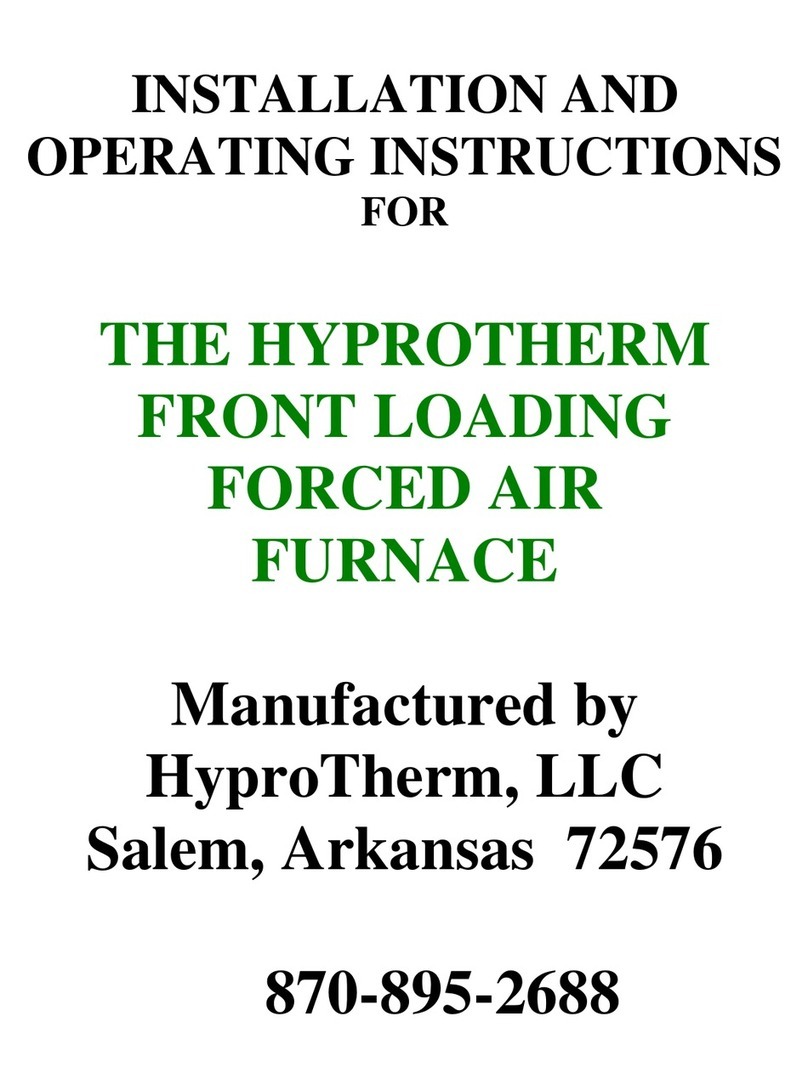
HyproTherm
HyproTherm FLFA - 2000 Installation and operating instructions
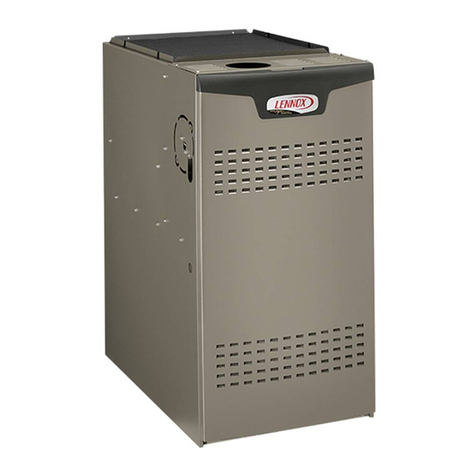
Lennox
Lennox EL280UH installation instructions
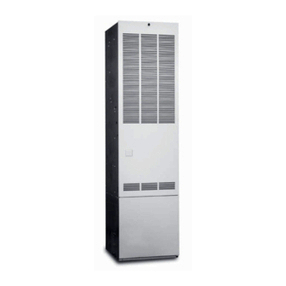
Nordyne
Nordyne M1B Owner's manual and installation instructions
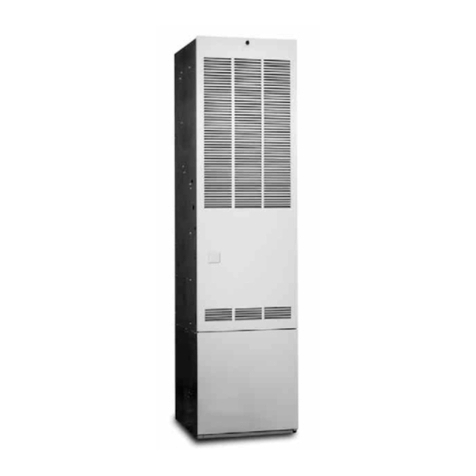
Intertherm
Intertherm M1B Series installation instructions
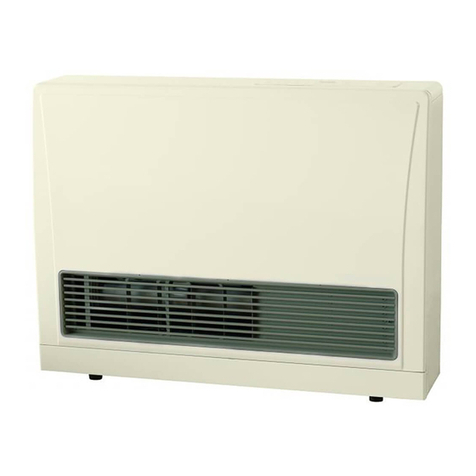
Rinnai
Rinnai EX22 Specifications

Suburban
Suburban SF-42F installation instructions

Empire Comfort Systems
Empire Comfort Systems 3588-1 owner's manual

Carrier
Carrier Deluxe 58SX Installation, Start-Up and Service Instructions

Amana
Amana GUD Series Service instructions
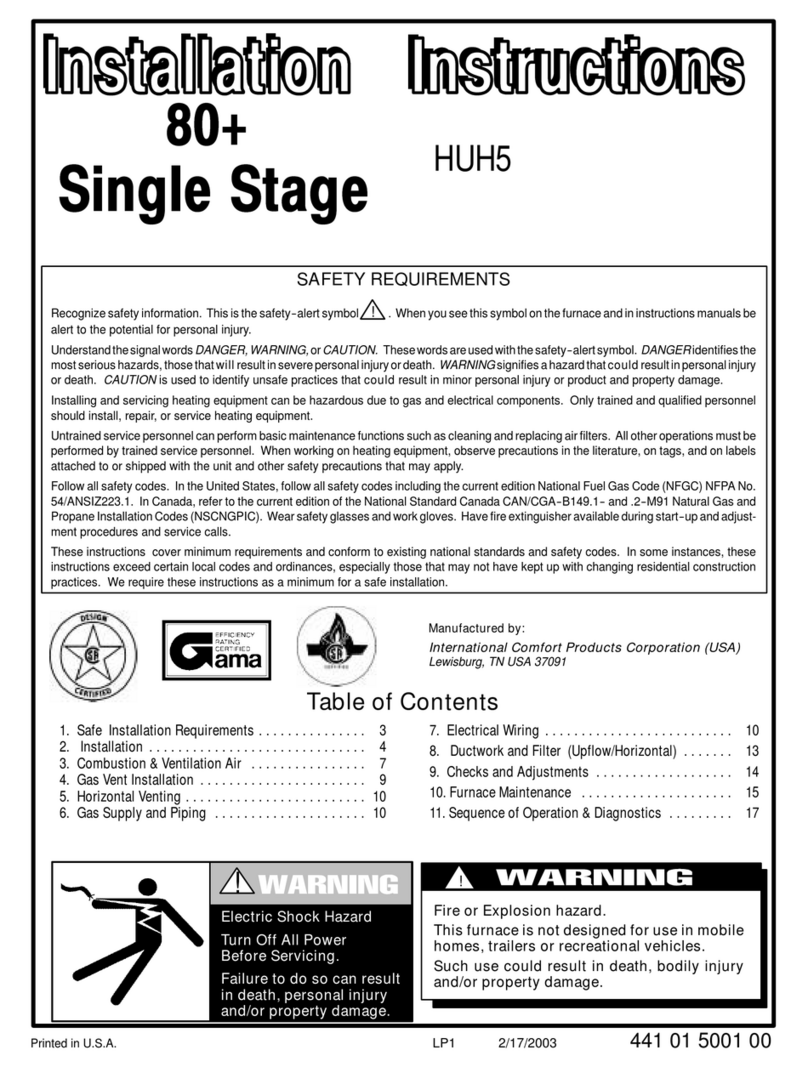
Tempstar
Tempstar HUH5 Series installation instructions

